What is the contribution of polymer capacitors to the spreading GaN-based AC/DC converters?
2023-01-20
AC/DC converter trends and GaN
AC/DC converters are used in various types of electronic products as devices that convert commercial AC power into DC power. They are essential because most electric loads use DC voltages rather than AC voltages. AC/DC converters vary in size depending on the power level required by the hardware. When compared with the same power, the smaller the size, the better from the viewpoint of space saving and portability.
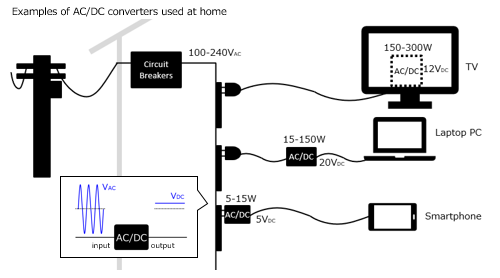
Historically, the progress of downsizing has been slow since AC/DC converters shifted from linear methods to switching methods.
However in recent years, as is often the case with AC adapters for notebook PCs, we have seen remarkable downsizings.
In addition to continuous circuit topology improvements, such remarkable changes are often due to the adoption of low-loss GaN (gallium nitride) as a switching element in place of conventional Si.

GaN usage for power supplies has been developed since around 2000. But it is in recent years that the momentum of practical GaN adoptions are becoming remarkable.
In the background, there has been a growing need for smaller size and higher efficiency due to social situation changes like the rise of mobile work and power shortages. And the improvement in quality and productivity of GaN itself has been matched.
Switching elements using GaN feature a smaller switching loss due to a faster switching speed compared to conventional Si materials. Therefore, compared to conventional Si, if the same switching frequency is selected, efficiency will be higher, heat will be reduced, and heat dissipation components will be simplified.
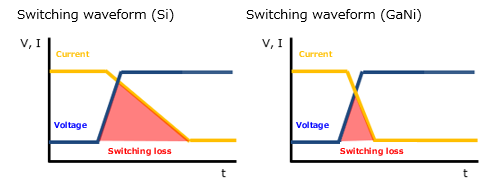
Also, it is OK to use a higher switching frequency for the sake of using smaller passive components. Because at a higher switching frequency, GaN can maintain the same good efficiency Si provided at a low switching frequency.
Generally, newer power supply designs are considered OK if it maintains the good power efficiency conventional designs achieved. So, GaN’s low loss advantage often leads to downsizing designs.

Advantages of polymer capacitors
Panasonic has a wide lineup of solid polymer capacitors, that can contribute to the downsizing of output capacitors for AC/DC converters that use GaN switches.
First, let’s see how an output capacitor works.
By absorbing the ripple current of the AC/DC converter, the output capacitor contributes to the clean DC current output to the subsequent circuit. Ripple voltage is always generated when the capacitor absorbs the ripple current. At the design verification, this ripple voltage is required not to exceed the limit values set for safe operation of the application, typically less than ±5% of the output voltage.
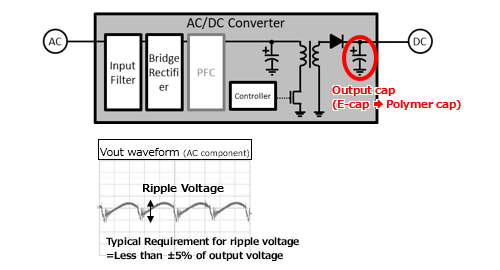
The main factor for obtaining small ripple on a DC output voltage is the impedance of the capacitor. Ripple voltage = ripple current x impedance (ΔV=ΔI*Z) is the basic relationship. So, it is optimal to use capacitors with as small an impedance as possible at the switching frequency (at which ripple current occurs).
With GaN, it is possible to use higher switching frequencies like 200k-500kHz due to the low switching loss, compared to 100kHz with conventional Si.
In such a high-frequency range, polymer capacitors have a much lower impedance than conventionally used liquid electrolytic capacitors. As a result, polymer capacitors can reduce ripple voltages much more, thus they are increasingly becoming the best output capacitors for AC/DC converter designs using GaN.
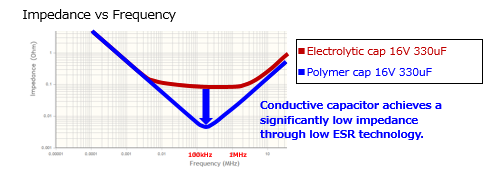
The low impedance of polymer capacitors is brought by using a low ESR conductive polymer material as the electrolyte.
The low ESR also means that it can tolerate higher ripple currents than electrolytic capacitors.
In addition, since conductive polymer is solid electrolyte unlike liquid electrolytic capacitors, the characteristics do not deteriorate in low temperature atmosphere, and in long-term high temperature uses. Those polymer capacitor advantages contribute customer designs in many ways.

Comparative evaluation with electrolytic capacitors in high-frequency AC/DC converters
In some cases, increasing the switching frequency can reduce capacitance and lead to significant downsizing and cost reductions. Let’s introduce one such case.
The evaluation example below is a high-frequency AC/DC converter that operates in the range of about 200k to 400k. Polymer capacitors realize the design with much smaller area and less component count than electrolytic capacitors do.
This is due to the excellent frequency and temperature characteristics of the polymer capacitor mentioned above.
1. Capacitor characteristics comparison
Device under test: Electrolytic capacitor 63V 390uF vs Polymer capacitor 63V 33uF

2. Circuit performance comparison
- AC/DC converter specs:
- Output power 150W, Output voltage 48V, Allowable voltage fluctuation range ±400mV, Fsw 210k-370kHz, LCC topology, Operating temperature range -30°C to +65°C, Expected life 50,000 hours (5.7 years)
- Test point:
- At 48V output of the AC/DC converter
- Test content:
- Measure the output ripple voltage at a maximum load of 3.2A including at lowest operating temperature for the worst condition.Compare the measurement result between the originally equipped electrolytic capacitor 63V 390uF x 3 and proposed Panasonic polymer capacitor 63V 33uF x 1-3,

=Reduced mounting area / cost / longer life
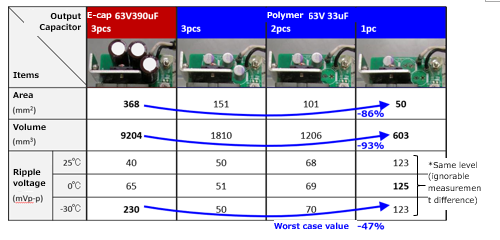
Panasonic Polymer capacitors
Panasonic is responding to customer needs for such high-frequency AC/DC converters, which are increasing with GaN adaptions.
As a pioneer of polymer capacitors, Panasonic has a lineup up to 100V products that use our unique high-performance and high-reliability technology.
They are widely used for 5-20V output, which is widely used in consumer electronics, 24V output for industrial equipment, and 48V output for network equipment.
In response to power shortage problems in recent years, the shifts to high-efficient 48V power distribution, has been increasing (ex. vehicles, data centers, USB-PD). Then polymer capacitors will be more active along with GaN.
| Product | Size | Feature | AC/DC Vout | Typical Applications |
|---|---|---|---|---|
Hybrid*  |
Area: φ5~10mm Height: 6.1~16.8mm |
Large cap, Large ripple current, Low LC, AEC-Q200 | 12~48V typ | Wide range automotive, industrial, and telecom products |
OS-CON |
Area: φ4~10mm Height: 4.5~13mm |
Large cap, Large ripple current, Wide voltage range | 5~48V typ | Wide range industrial, telecom, and consumer products |
POSCAP |
Area: 3.5x2.8, 7.3x4.3mm Height: 1.2~4mm |
Small, Large cap | 5~28V typ | Low power, small AC adaptor or charger |
SP-Cap |
Area: 7.3x4.3mm Height: 1~3mm |
Low profile, Low ESR | 5V typ | Low power, small AC adaptor or charger |
Examples of power IC reference adoption
Now let’s us introduce the real examples of AC/DC converters using polymer capacitors.
STMicroelectronics, which is one of long-year competitive players in the IC industry, recently released high performance GaN devices.
In the latest AC/DC converter reference boards that use the GaN, Panasonic polymer capacitors are used.
- Board name:
- EVLONE65W
- Description:
- 65Wout, 90-265Vin, 3.3-21Vout, 3.75Aout max, USB-PD, ACF topology
- Featured IC:
- MasterGaN4(GaN switching power device)
ST-ONE(Controller) - Application:
- Industrial & Consumer Electronics
- Output cap:
- EEHZS1V681UP(Hybrid Cap)、25SEK270M(OS-CON)
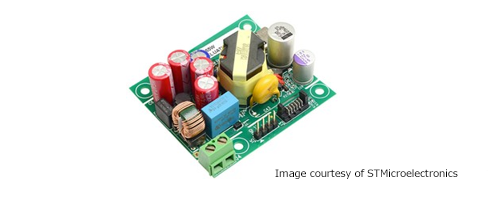
- Board name:
- EVLMG1-250WLLC
- Description:
- 250Wout, 400Vin typ, 24Vout typ, LLC topology
- Featured IC:
- MasterGaN1(GaN switching power device)
L6599A(Controller) - Application:
- Industrial & Consumer Electronics
- Output cap:
- EEHZA1V151P(Hybrid Cap)
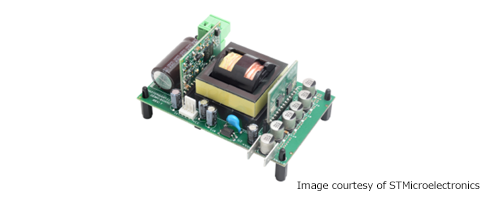
Summary
In coming future, in order to realize a sustainable society amid the increase in electronic devices and the increase in power consumption, it is expected that the adoption of GaN will increase more and more. Because power supply downsizing (=resources saving) and efficiency improvement (=energy saving) should be very essential.
GaN is being used not only in the AC/DC converters featured in this article, but also more wide applications like high-voltage DC/DC converters, base station RF amplifiers, and so on.
Panasonic polymer capacitors will continue to strive to meet customer needs as components that can contribute to new generation power supplies using GaN.
